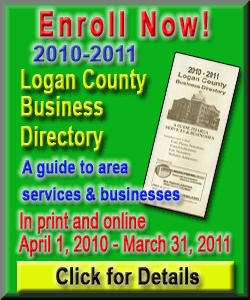 They were daring to face head-on the negative issues that lie within
the boundaries of their town and even the borders of their county. They were daring to face head-on the negative issues that lie within
the boundaries of their town and even the borders of their county.
As LCU President Keith Ray led the group through the book "Caught in
the Middle," by Richard C. Longworth, he divided the book into three
segments: the bad news, the good news and making news.
At the end of the first segment, the group may have been more
sober in spirit, but they were also more enlightened.
Ray had commented at one point that "somehow, we like to be at
the bottom of the barrel before we start looking up. I think we're
close enough that this book will help us see how the bottom of the
barrel looks."
The bad news segment revealed the bottom of the barrel, and then
as he led the group into the good news segment, they began to see
that there are ways to revive our community, based on its current
strengths.
The good news

"There is some good news out there," Ray stated as he opened the
second segment. "We need to embrace it."
A study from the University of Illinois, published in Science
Daily in January, stated that in the heartland, which includes
Indiana, Illinois and Iowa, half of the counties are economically
prospering.
The prospering counties were doing so because they had more farm
jobs, they were an educated population, there was less income in
equity, and finally the communities had civically engaged religious
groups.
The study said that local action had made all the difference.
There is a link between local churches and shared ethnic identities.
Also playing into their prosperity were small colleges in the
areas. Ray drew on this, saying that Logan County was fortunate to
have not one, but three colleges.
Ray reminded the group that the Midwest set the pace in the
industrial revolution, but now somehow we have lost it.
Longworth wrote that the future lies not in Alabama or Las Vegas,
but in the heartland, one of the most resourceful places on planet
Earth.
Ray commented further: "We have the history; we have cases where
rural counties are prospering and the reason for it. Our educational
base is a global one. The Midwest has the highest concentration of
flagship universities in the world."
The unfortunate part of this is that our highly educated are not
staying local. They take what they learn and go to other regions
where they can make more money.
The single best hope for small rural communities will be the
fastest growing segment of the U.S. population: Latinos.
Ray noted specifically that Latinos are already migrating into
the Midwest. He cited Beardstown, which has benefited a great deal
from this immigration.
Ray said that the simple truth is towns with immigration are
growing; those without immigration are shrinking.
Ray had at the beginning of the morning told the group that he
had just recently returned from a two-week trip to China,
representing his university.
Now as he spoke about growth through immigration, he told the
group that one of the reasons he was engaging China was with the
hope of seeing Chinese students in his university within the next
year or so.
Ray said, "So here is my question: Is Lincoln ready to deal
(with) the Chinese culture?"
Ray moved on, saying one of the conclusions of the good news
segment was this simple statement: "The new Midwesterner must
embrace differences."
He said the good news that exists in the community needs to
be exploited. He expressed a desire to flood the local media with
all the good that is going on.
[to top of second column] |
 He asked the group to talk about the victories -- even now what
is out there that is really good in the city and the county.
Alderwoman Kathy Horn spoke up, saying that the Together for
Lincoln program was an amazing asset to the community. She said that
she has talked to people who really just cannot believe all that
group has done for Lincoln.
Together for Lincoln is a collaboration between the majority of
the local churches, wherein members gather together and perform
community service projects, which include downtown cleanups,
building wheelchair ramps, making home repairs for those who are
unable to do it themselves, and this past year even donating time to
cleaning up and painting one city-owned building.
It would appear that the Together for Lincoln projects would be
fine examples of civically minded religious groups.
Dave Schonauer of Illinois American Water said that our
educational systems were a great asset. "Three colleges in town with
a population of 15,000 people is unheard of," he said. "The
educational system we have with the parochial systems and public
education systems, I don't know where we rate, but I do know our
teachers work really hard." He continued his comments by mentioning
the new hospital campus being built, as well as Castle Manor for
senior living accommodations, and ended with comments on our
location: Being in the heart of a three-major-city triangle is an
advantage.
Ray added to the comments, saying that one of Longworth's points
in his book is that many rural communities are much more isolated
than Logan County is.
Chris Ilam, representing Main Street Lincoln, said that the town has
a good number of vacant buildings that can be offered to new
businesses.
Andi Hake of the chamber of commerce also counted the community
partnerships through Community Action as an asset in that they offer
many resources for those in need.
Jan Schumacher, who is one of the newer members of the Logan
County Board, said that she felt the recent changes in leadership on
a city and county level were making a difference.

Ivan Ray, a longtime businessman in Lincoln and father of Keith
Ray, stood and said, "The government and the county board needs to
support what you are doing." He went on to talk about when the Zion
Lutheran School was built, not in the city limits, and how the city
supported extending those limits for the school. He recounted that
as a good example of the city working with the citizenry.
Other items that were mentioned included the value of tourism in
the city and county, the volunteer base within the communities, and
the fact that there is still plenty of room for geographical growth
in the city of Lincoln.
While the discussions could probably have gone on much longer,
Ray said that in keeping with the time schedule, he needed to move
on to the third and final segment of the book.
[By NILA SMITH]
Previous article in
series

 |